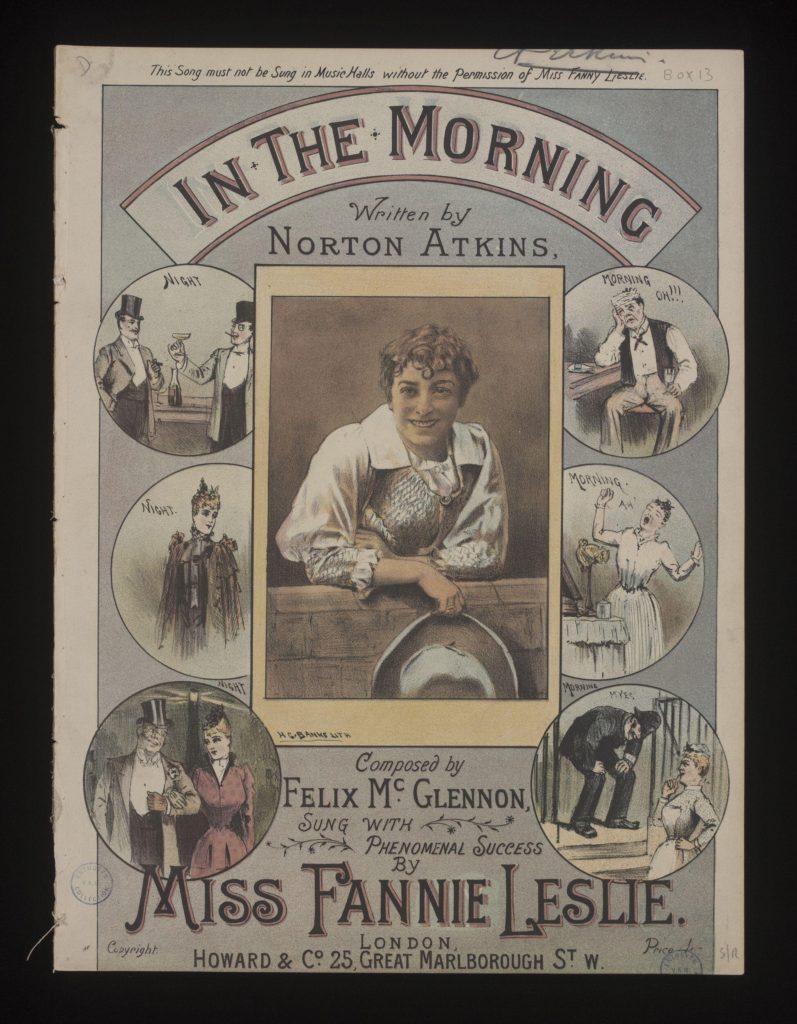Oh! What a difference in the morning
| AKA | But Oh! What a difference in the morning In the morning At night! At night! |
| First Published | 1891 |
| Writer/composer | Norton Atkins / Felix McGlennon | Roud | RN32784 |
| Music Hall Performers | Fannie Leslie |
| Folk performances | Collected from the singing of: Rowe, Cliff; England : Somerset; 1977 |
OH! WHAT A DIFFERENCE IN THE MORNING. Written by Norton Atkins. Composed by Felix McGlennon. I'll sing of the curious sights that we see At night, at night; They're awfully funny, I think you'll agree, At night, at night. There's Johnny, the waiter, who hasn't much cash, He likes with his pals to appear very flash. So he calls for champagne, and he cuts such a dash, At night, at night. But oh! don't his head ache in the morning, Then comes repentance with the dawning, It's twice its usual size, and he's got two fine black eyes, And he's glad to get a seltzer in the morning. There are ladies who go for a walk up Broadway At night, at night; Their figures are handsome, they seem very gay, At night, at night. Their waists are so dainty, complexion so new, And tootsies so neat in a number two shoe, With hair of such delicate straw-colored hue, At night, at night. But, oh! what a difference in the morning, What an alteration with the dawning; Observe her in her room, on her checks there's little bloom, And her hair lies on the table in the morning. And then there's the frivolous, gay married man At night, at night; To tell what he gets at, is part of my plan, At night, at night. With plenty of money He goes on a booze, He meets some old pals, and they have a carouse, And when be gets home on the door-step he'll snooze, At night, at night. But, oh! what a difference In the morning. Then comes repentance with the dawning; Tho' he's very, very dry, for a drink he'd vainly cry, For his wife's been thru' his pockets In the morning.
A fragment of this song was collected from the singing of Cliff Rowe by Bob and Jacqueline Patton in 1977. You can hear it in the British Library Sound Archive

The original song, under the title In The Morning, was a huge hit for Fannie Leslie when she relaunched her Music Hall career in 1891. Such was its success that she bought silver cigar cases for both the composer, Felix McGlennon and lyricist Norton Atkins – the gifts were widely publicised and might be seen as something of a marketing ploy.
The song enjoyed further success in America where it was sung both by blackface minstrels and vaudeville artists, notably Lottie Gilson. The song was modified to meet the needs of various performers and audiences and both sheet music and broadsides show considerable variation in the lyrics.
The words given above are from an early American version of the song credited to Norton Atkins and I suspect the original British words have been modified slightly for an American audience. Unfortunately, thus far I have been able to access the original British sheet music associated with the cover shown above to check the original lyrics.
The song was the subject of a dispute in the letters page of The Era newspaper, which give a precise timeline for the production of the song and an interesting insight to the business model of the composer Felix McGlennon. Reproduced below are two letters responding to the allegation made by Victor Stevens that Fannie Leslie’s hit song “bears a very strong family likeness to” a song he wrote collaboration with Harry Dacre:

Interestingly the site monologues.co.uk suggests that Fannie Leslie sang another song also called In The Morning (monologues.co.uk)
Sources:
- Entries in the Roud Indexes at the Vaughn Williams Memorial Library: https://archives.vwml.org/search/all:single[folksong-broadside-books]/0_50/all/score_desc/extended-roudNo_tr%3A32784
- Kilgarrif Sing Us
- Lyrics: Wehrman’s Songbook No 33
- Sheet Music with lyrics by Harry Miller in Levy collection
- Sheet Music with addition lines by “MCJ” University of Maine and New York Public Library
- Sheet Music adapted by Monroe Rosenfield, sung by Lew Dockstader Levy collection
- Original Sheet Music cover (c) Victoria and Albert Museum